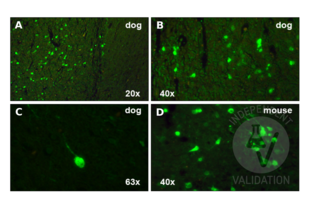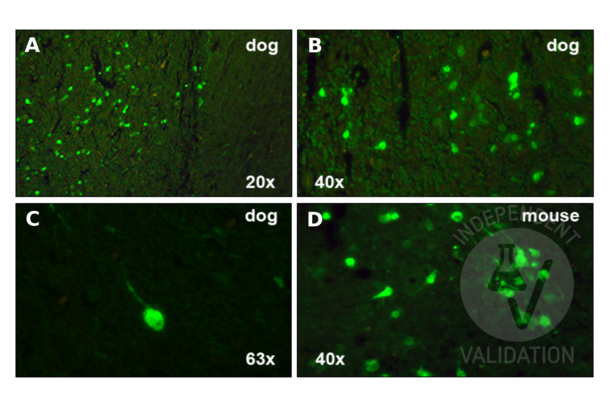Calretinin Anticorps

 Calretinin anticorps (ABIN2855596)
Calretinin anticorps (ABIN2855596)
CALB2 Reactivité: Humain WB, IHC (p), IF, ICC, IHC (fro) Hôte: Lapin Polyclonal unconjugated
CALB2 Reactivité: Humain WB, IHC, IP, ICC Hôte: Lapin Polyclonal unconjugated
CALB2 Reactivité: Humain WB, IHC, StM Hôte: Souris Monoclonal CALB2-2602 unconjugated
Calretinin Anticorps par Grade
On trouve ici des Calretinin Anticorps avec un Grade spécifique. Les Grade mentionnés ici sont quelques-uns de ceux qui sont disponibles. Un clic sur le lien correspondant permet d'accéder aux produits
Calretinin Anticorps par Hote
On trouve ici des Calretinin Anticorps avec un Hote spécifique. Les Hote mentionnés ici sont quelques-uns de ceux qui sont disponibles. Un clic sur le lien correspondant permet d'accéder aux produits
Calretinin Anticorps par Clonalité
Trouvez les Calretinin Anticorps monoclonaux ou polyclonaux disponibles. Cliquez sur un lien pour accéder aux produits correspondants.
Calretinin Anticorps fréquemment utilisés
- (1)
- (6)
- (1)
- (7)
- (6)
- (7)
- (5)
- (5)
- (5)
- (5)
- (1)
- (2)
- (3)
- (3)
- (3)
- (6)
- (3)
- (3)
- (3)
- (2)
Dernières publications pour nos Calretinin Anticorps
: "Regional Patterning of Adult Neurogenesis in the Homing Pigeon's Brain." dans: Frontiers in psychology, Vol. 13, pp. 889001, (2022) (PubMed).: "Disrupted in Schizophrenia 1 regulates the processing of reelin in the perinatal cortex." dans: Schizophrenia research, Vol. 215, pp. 506-513, (2021) (PubMed).
: "Dual embryonic origin of the mammalian enteric nervous system." dans: Developmental biology, Vol. 445, Issue 2, pp. 256-270, (2019) (PubMed).
: "Male germ cells support long-term propagation of Zika virus." dans: Nature communications, Vol. 9, Issue 1, pp. 2090, (2018) (PubMed).
: "Multiple amygdaloid divisions of arcopallium send convergent projections to the nucleus accumbens and neighboring subpallial amygdala regions in the domestic chicken: a selective pathway tracing and ..." dans: Brain structure & function, (2016) (PubMed).
: "Multiwalled carbon nanotubes intratracheally instilled into the rat lung induce development of pleural malignant mesothelioma and lung tumors." dans: Cancer science, Vol. 107, Issue 7, pp. 924-35, (2016) (PubMed).
: "Immunofluorescent visualization of mouse interneuron subtypes." dans: F1000Research, Vol. 3, pp. 242, (2014) (PubMed).
: "Cell age-specific vulnerability of neurons to anesthetic toxicity." dans: Annals of neurology, Vol. 73, Issue 6, pp. 695-704, (2013) (PubMed).
: "Tissue profiling of the mammalian central nervous system using human antibody-based proteomics." dans: Molecular & cellular proteomics : MCP, Vol. 8, Issue 7, pp. 1612-22, (2009) (PubMed).
: "Functional remodeling of glutamate receptors by inner retinal neurons occurs from an early stage of retinal degeneration." dans: The Journal of comparative neurology, Vol. 514, Issue 5, pp. 473-91, (2009) (PubMed).
Pseudonymes pour Calretinin Anticorps
calbindin 2 (CALB2) Anticorpscalbindin 2 (Calb2) Anticorps
calbindin 2a (calb2a) Anticorps
calbindin 2b (calb2b) Anticorps
CAB29 Anticorps
CAL2 Anticorps
calb2 Anticorps
calb2l Anticorps
CR Anticorps
wu:fq17g09 Anticorps
wu:fq18e08 Anticorps
zgc:73099 Anticorps
zgc:73115 Anticorps
Avez-vous cherché autre chose?
- Calreticulin 3 Anticorps
- Calreticulin Anticorps
- Calprotectin Anticorps
- Calpastatin Anticorps
- Calpain S1 Anticorps
- Calpain 9 Anticorps
- Calpain 8 Anticorps
- Calpain 7 Anticorps
- Calpain 6 Anticorps
- Calpain 5 Anticorps
- Calpain 3 Anticorps
- Calpain 2, (M/II) Large Subunit Anticorps
- Calpain 2 Anticorps
- Calpain 15/SOLH Anticorps
- Calpain 14 Anticorps
- Calpain 1, Large Subunit Anticorps
- Calnexin Anticorps
- Calneuron 1 Anticorps
- Calmodulin,CAM Anticorps
- Calmodulin-Lysine N-Methyltransferase Anticorps
- Calsequestrin 1 Anticorps
- Calsyntenin 1 Anticorps
- Calsyntenin 2 Anticorps
- Calsyntenin 3 Anticorps
- CALU Anticorps
- CALY Anticorps
- CAMK1 Anticorps
- CAMK1D Anticorps
- CAMK1G Anticorps
- CAMK2A Anticorps
- CAMK2B Anticorps
- CAMK2D Anticorps
- CAMK2N1 Anticorps
- CAMK4 Anticorps
- CAMKII gamma Anticorps
- CAMKK1 Anticorps
- CAMKK2 Anticorps
- CAMKV Anticorps
- CAMLG Anticorps
- CAMP Anticorps




